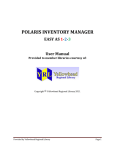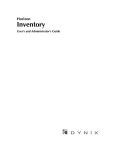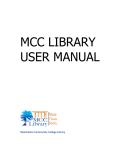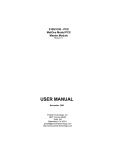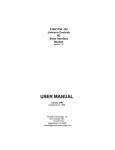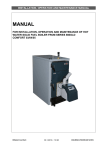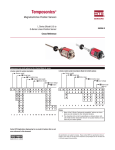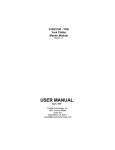Download polaris inventory manager (pim)
Transcript
1 POLARIS INVENTORY MANAGER (PIM) EASY AS 1-2-3 User Manual Provided to member libraries courtesy of: Polaris Inventory Manager (PIM) Copyright © Yellowhead Regional Library 2009 2 Contents: Introduction……………………………………………………………………………….. 3 What will you need ……………………………………………………………………. 3 Before you begin ……………………………………………………………………….. 3 Step 1 – LOAD…………………………………………………………………………….. 4-5 Step 2 – SCAN ……………………………………………………………………………………………… 6-10 Setting Inventory Preferences ……………………………………………………. 6-9 Step 3 – UPDATE THE DATABASE ……………………………………………….. 11-13 Update the inventory date of out-of-range items ………………………. 13 Inventory Reports in the Staff Client ………………………………………….. 13 Polaris Inventory Manager (PIM) Copyright © Yellowhead Regional Library 2009 3 INTRODUCTION: What YOU Need to Know About PIM (Polaris Inventory Manager) What will you need? All required equipment will be provided to your library by YRL. You should receive a laptop equipped with PIM and a wireless barcode scanner. You can do the inventory visually (by checking boxes rather than scanning) but this is not recommended. You will need a network connection to update the inventory data into Polaris but not while you take the inventory. What will PIM do? PIM will identify items that are misshelved, have a status other than “IN”, or satisfy hold requests. You can also mark items for weeding. You CAN stop or resume your session at any time. You can close and re-open PIM without losing data. When you are finished a section, PIM updates to the Polaris database when prompted. (This is when you need the network connection) A PDF report is automatically generated along with an optional .txt file (you might want a .txt file if you want to upload the data into excel at a later date). You set the parameters for the reports and PIM in general to ensure you are only getting information that matters to YOU. PIM can create record sets in Polaris if you choose. Additional standard/custom reports can be run in the Polaris staff client after. PIM also has a cart feature. Before You Begin… Are your shelves in good order? Are items consistently catalogued? You should ensure that collection codes and shelf locations are consistent… for example; J and Juv may have been used interchangeably over the years… you may want to create Polaris record sets and do some bulk changes to make one collection. A good place to start would be to run a report of current collection codes and compare with the sections in your library. YRL can help you with this if needed. Polaris Inventory Manager (PIM) Copyright © Yellowhead Regional Library 2009 4 EASY AS 1-2-3 Step 1 LOAD From the File Menu, Choose LOAD. As shown below, you choose your branch at the top… then your available shelf locations and collections will populate. There are 3 ways to LOAD data from Polaris… choose one. 1. By Record Set… You may use this feature for items that may not necessarily follow regular Call # formats… scan them into a record set and inventory them that way. It is also a good way to polish off your inventory if there are random items left over once the collections have been completed. 2. By Shelf Collection… You can also choose to exclude selected shelf locations For example: If you have a travel section somewhere in your library not interfiled with your non-fiction… you could inventory the NF excluding the Travel shelf location. Record Sets and Bulk changes are a good way to set shelf locations. Ask YRL for assistance if required. 3. By Collection… You can choose from a list of collections that are specific to your library. Polaris Inventory Manager (PIM) Copyright © Yellowhead Regional Library 2009 5 Notes: You MUST enter values in the Call # fields… I recommend using an asterisk* as a wildcard for the most part to ensure you are not eliminating items with faulty Call #s. You may select more than one collection or shelf location at a time by highlighting it and moving them all to the LOAD field. It is important to ensure collection codes are correct. For example: When I started at my library, we had 67 collection codes, now we have 30. This can be corrected by using the Polaris Record Sets and Bulk change features. Remember to record the call number and date for each set of items that you LOAD as you will need this information later to run reports in the Staff Client. Click LOAD on the bottom right hand corner to gather the data from Polaris. You may select Close from the File Menu. Now you are back to the PIM Main Window (below). Polaris Inventory Manager (PIM) Copyright © Yellowhead Regional Library 2009 6 Step 2 SCAN Choose Scan from the File Menu. This is where you will see the list of titles that you just loaded. This is called the Process Items Window/Inventory List. You can start scanning items right now or you can customize PIM… Now from the File Menu you can choose Preferences. This is where you can set the parameters to ensure you are getting the information that you require. You can choose which Alerts to activate (by selecting the check box) On the left hand column; there are other options (Appearance, Collections, Columns, Shelf Locations, and Statuses) Polaris Inventory Manager (PIM) Copyright © Yellowhead Regional Library 2009 7 The Appearance Options (by selection on the left) may be adjusted if necessary. Note the Skipped Item Sensitivity… If you are going to scan items that you know are out of order; you may wish to up the number in this field. Maximum is 20. This is a good idea if you shelve by author, but not necessarily by title or if there are display items within your shelves. If you specified multiple collections to load, you can select Collections in the left hand column and choose which ones are actually displayed in the Process Items Inventory List. Polaris Inventory Manager (PIM) Copyright © Yellowhead Regional Library 2009 8 Columns can be selected on the left hand side… you can choose what information displays by highlighting the selection and using the arrows below to move between Displayed and Not-Displayed. You can use the up and down arrows below to change the order of the columns as they appear from left to right in the Process Items Inventory List. (Top of the list = far left when displayed) Note: The Weed column is always displayed but you can change its location. If you specified multiple Shelf Locations to LOAD, you can choose which of those loaded are actually displayed in the Inventory List, then change your selections when needed as you take inventory. Polaris Inventory Manager (PIM) Copyright © Yellowhead Regional Library 2009 9 The last Preference is Statuses… You can choose to suppress certain statuses from the list… for example; you may wish to suppress On-Order Items from the list. Select OK. The Process Items Window will now open with the inventory list according to the preferences you set. Now – Scan your items in Call No. order (or check them off using the check boxes – not recommended). Polaris Inventory Manager (PIM) Copyright © Yellowhead Regional Library 2009 10 Notes: If a barcode does not scan properly, you can key in a barcode. Then select Process. The list jumps to the position of the keyed item and the Done box is checked for that item. The following messages may appear: Item not found in the current call number range – Select OK on the message box and set the item aside. When you update the Polaris database, a .txt file that lists the out-of-range barcodes is automatically created. You can view and update these items in the Polaris Staff Client later. Item’s status is not IN – For example: the item may be checked out or marked LOST. Select OK on the message box and set the item aside. These items should be checked in using circulations functions in the Polaris Staff Client later. The status of this item is [status] – You chose to filter certain statuses from display (when you set your preferences) Select OK on the message box and set the item aside for appropriate processing later. Item fills a hold request – Select OK on the message box and set the items aside. Check them into the Polaris Staff Client later to transfer the item for ILL. Item is misshelved – Select OK on the message box and set aside for proper shelving. Remember* If the item is NOT misshelved, make sure to clear the misshelved check box for that item. If you want to mark items for weeding, select the appropriate check box for that item. These items can be listed on a report when you upload your inventory data into the Polaris database, and you can create a record set of the items at that time. Select File, Close, or select X in the upper right hand corner of the Process Items window. The main window appears. You can resume the inventory at any time. When you have finished the set of items, you are ready for Step 3 Polaris Inventory Manager (PIM) Copyright © Yellowhead Regional Library 2009 11 Step 3 UPDATE THE DATABASE When you update the Polaris database with your inventory data, the inventory date for the relevant items is updated and an Inventory Statistics report is automatically generated as a .pdf file. The report contains information such as the update date and time, the date and time the item information was loaded, branch and call number range or record set, and totals. You can select any or all of the following sub-reports to include in the Inventory Statistics report: Misshelved sub-report Out-of-range sub-report Items Not In sub-report Expected Items Not Processed sub-report Weeding sub-report The report is placed in the following location based on your operating system: Windows XP: c:\Documents and Settings\All Users\Application Data\Polaris\Polaris Inventory Manager\YYYYMMDD Time Windows Vista: c:\Program Data\Polaris\Polaris Inventory Manager\YYYYMMDD Time *You can also choose to create Polaris record sets of items that: were expected but not processed (named: PIM_branch abbreviation_date_time) marked for weeding (named: PIM_WEEDING_branch abbreviation_date_time). The record set owner is the branch specified when the item data was loaded, and the default record set note is the call number range of the inventoried items. To UPLOAD the completed section of inventory: 1. Establish a network connection on the laptop used for the inventory. 2. On the main window of PIM, Select File, Update. Polaris Inventory Manager (PIM) Copyright © Yellowhead Regional Library 2009 12 3. Select (check) or deselect the sub-reports to include in the Inventory Statistics report. 4. Click Update. Messages are displayed as the OutofRange.txt file and Inventory Statistics report are generated. If an OutofRange.txt file is being created, you will be prompted to choose a location for a copy of the file. The default location is always: Windows XP: C:\Documents and settings\All Users\Application Data\Polaris\Polaris Inventory Manager\YYYYMMDD Time Windows Vista: C:\ProgramData\Polaris\Polaris Inventory Manager\YYYYMMDD Time This default copy is deleted if you load a new call number range without updating the database. *You may see an option to create a record set in Polaris. Click YES to create the record set. *The maximum number of expected but not processed items that can be shown on the Inventory Statistics report is 5000. If you marked items for weeding, you will be prompted to create an optional Polaris record set. Finally, a message indicates that the update was successful and the Inventory Statistics report opens as a .pdf file. *If you have previously updated the database, you can now view the other reports. Select File, Report on the main PIM window. 5. Click OK The Update window closes and the PIM main window opens. 6. Select File, Exit to quit PIM. *If you still have loaded items not completely inventoried, the next time you open the PIM main window, Select File, Scan to position the list at the next item to be processed. Polaris Inventory Manager (PIM) Copyright © Yellowhead Regional Library 2009 13 *In the Polaris Staff Client, the inventory date is displayed in the Last Inventory Date field of the Item record. Update the inventory date of the Out-of-Range Items 1. 2. 3. 4. Log into the Polaris Staff Client on the laptop that you used to complete the inventory. Select Circulation, Check In Select View, Update Inventory Date Press CTRL+ALT+I (An explorer window will open.) 5. Browse to and select the OutofRange.txt file. The locations again are: Windows XP: C:\Documents and settings\All Users\Application Data\Polaris\Polaris Inventory Manager\YYYYMMDD Time Windows Vista: C:\ProgramData\Polaris\Polaris Inventory Manager\YYYYMMDD Time The items are listed on the work form. For each item, the Comments column lists whether the inventory date was updated successfully and any other pertinent information. Inventory Reports in the Staff Client After the database has been updated, you can run standard inventory reports from the Polaris Staff Client. *To access the standard reports, select Utilities, Reports and Notices on the Polaris shortcut bar. The following reports are available under Cataloging, Item: Inventory Exception Incorrect Status – List items that had a status other than IN during inventory. You specify a call number range and a cut-off date. Set the cut-off date to the day before the inventory date. You can filter the report by organization. Inventory Exception Misshelved – Lists items with a status of IN that should have been in the inventory sequence but were not. You specify a call number range and a cut-off date. Set the cut-off date to the date you started the inventory. You can filter the report by organization. Inventory Shelf List – Lists inventoried items in a specific call number and date range. You can filter the report by organization. *In order to run these reports you must have the date and call number information from your inventory. CONGRATULATIONS! Welcome to Polaris Inventory Manager EASY AS 1-2-3 Polaris Inventory Manager (PIM) Copyright © Yellowhead Regional Library 2009














